Theories Influencing Organizational Action: Resource Dependency Focus
VerifiedAdded on 2023/06/04
|11
|2958
|362
Essay
AI Summary
This essay explores the influence of Resource Dependency Theory, Institutional Theory, and Population Ecology on organizational action and managerial decision-making. It argues that Resource Dependency Theory is a key factor in shaping organizational strategies, emphasizing the importance of adapting to environmental factors for survival. The analysis includes the application of each theory, highlighting how organizations utilize Resource Dependency Theory for decision-making by adapting to environmental factors. The essay also draws connections between Resource Dependency Theory and other theories, such as population ecology, institutional theory, and contingent theory, to provide a comprehensive understanding of the factors that influence organizational behavior. It concludes that managers often prefer strategic choice models, particularly those aligned with Resource Dependency Theory, when making critical decisions.
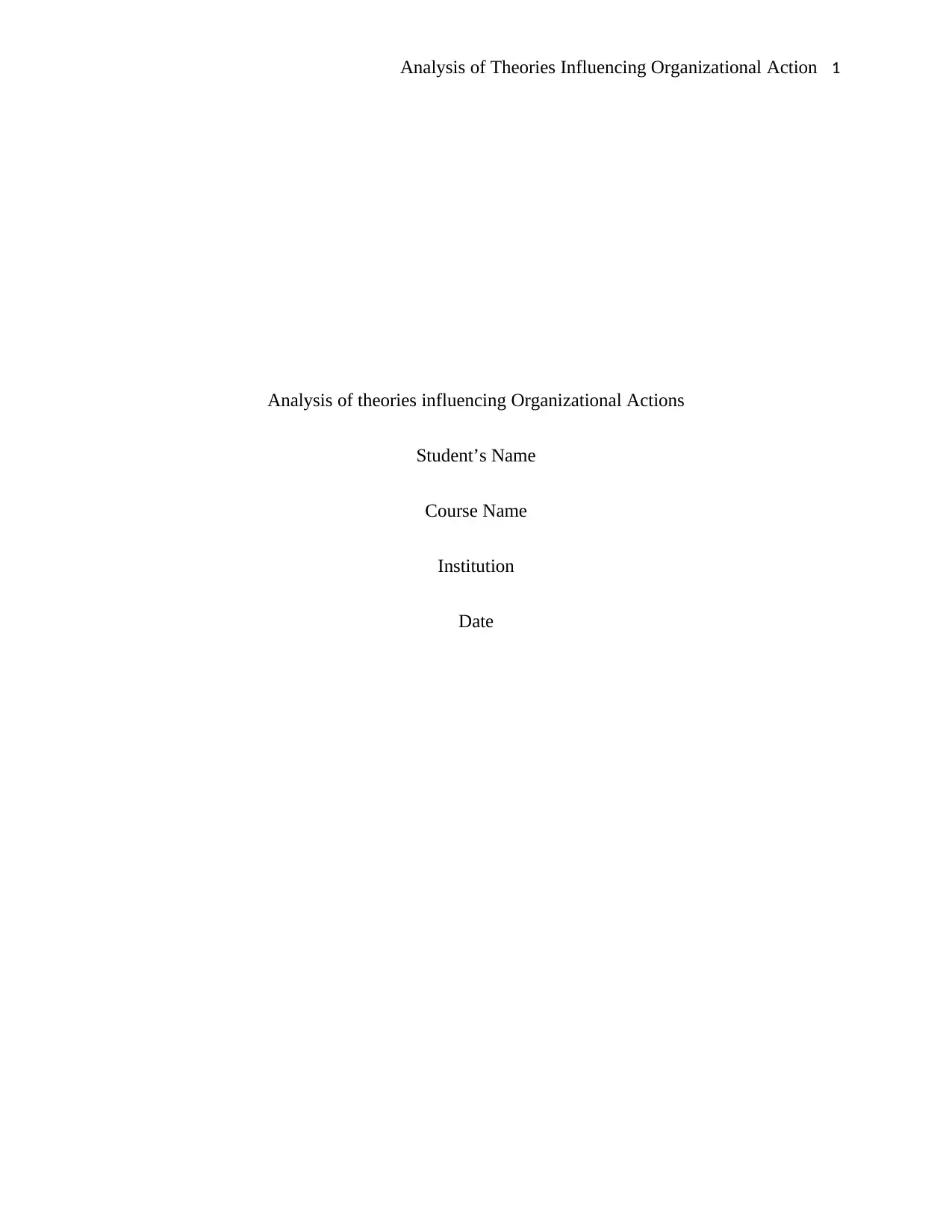
Analysis of Theories Influencing Organizational Action 1
Analysis of theories influencing Organizational Actions
Student’s Name
Course Name
Institution
Date
Analysis of theories influencing Organizational Actions
Student’s Name
Course Name
Institution
Date
Paraphrase This Document
Need a fresh take? Get an instant paraphrase of this document with our AI Paraphraser
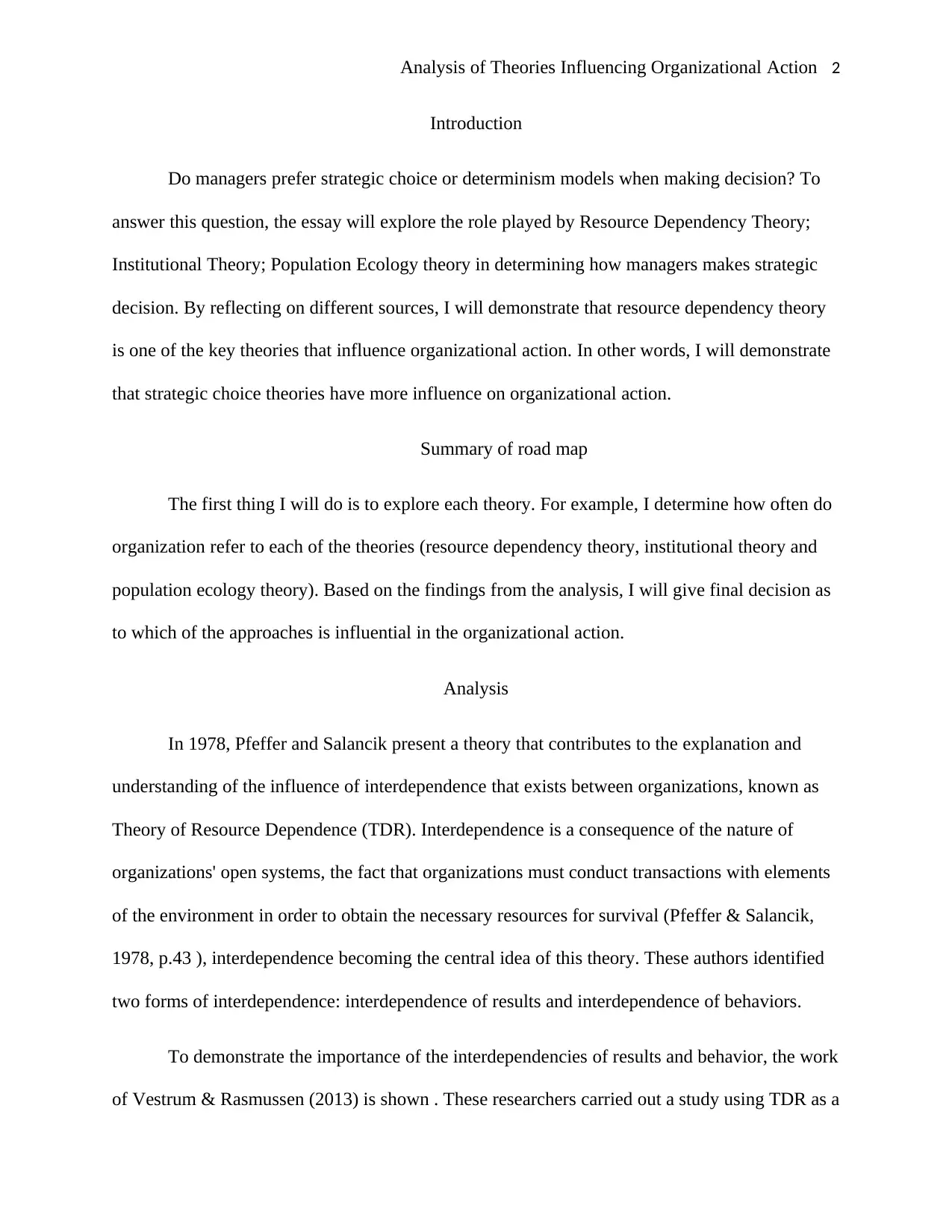
Analysis of Theories Influencing Organizational Action 2
Introduction
Do managers prefer strategic choice or determinism models when making decision? To
answer this question, the essay will explore the role played by Resource Dependency Theory;
Institutional Theory; Population Ecology theory in determining how managers makes strategic
decision. By reflecting on different sources, I will demonstrate that resource dependency theory
is one of the key theories that influence organizational action. In other words, I will demonstrate
that strategic choice theories have more influence on organizational action.
Summary of road map
The first thing I will do is to explore each theory. For example, I determine how often do
organization refer to each of the theories (resource dependency theory, institutional theory and
population ecology theory). Based on the findings from the analysis, I will give final decision as
to which of the approaches is influential in the organizational action.
Analysis
In 1978, Pfeffer and Salancik present a theory that contributes to the explanation and
understanding of the influence of interdependence that exists between organizations, known as
Theory of Resource Dependence (TDR). Interdependence is a consequence of the nature of
organizations' open systems, the fact that organizations must conduct transactions with elements
of the environment in order to obtain the necessary resources for survival (Pfeffer & Salancik,
1978, p.43 ), interdependence becoming the central idea of this theory. These authors identified
two forms of interdependence: interdependence of results and interdependence of behaviors.
To demonstrate the importance of the interdependencies of results and behavior, the work
of Vestrum & Rasmussen (2013) is shown . These researchers carried out a study using TDR as a
Introduction
Do managers prefer strategic choice or determinism models when making decision? To
answer this question, the essay will explore the role played by Resource Dependency Theory;
Institutional Theory; Population Ecology theory in determining how managers makes strategic
decision. By reflecting on different sources, I will demonstrate that resource dependency theory
is one of the key theories that influence organizational action. In other words, I will demonstrate
that strategic choice theories have more influence on organizational action.
Summary of road map
The first thing I will do is to explore each theory. For example, I determine how often do
organization refer to each of the theories (resource dependency theory, institutional theory and
population ecology theory). Based on the findings from the analysis, I will give final decision as
to which of the approaches is influential in the organizational action.
Analysis
In 1978, Pfeffer and Salancik present a theory that contributes to the explanation and
understanding of the influence of interdependence that exists between organizations, known as
Theory of Resource Dependence (TDR). Interdependence is a consequence of the nature of
organizations' open systems, the fact that organizations must conduct transactions with elements
of the environment in order to obtain the necessary resources for survival (Pfeffer & Salancik,
1978, p.43 ), interdependence becoming the central idea of this theory. These authors identified
two forms of interdependence: interdependence of results and interdependence of behaviors.
To demonstrate the importance of the interdependencies of results and behavior, the work
of Vestrum & Rasmussen (2013) is shown . These researchers carried out a study using TDR as a
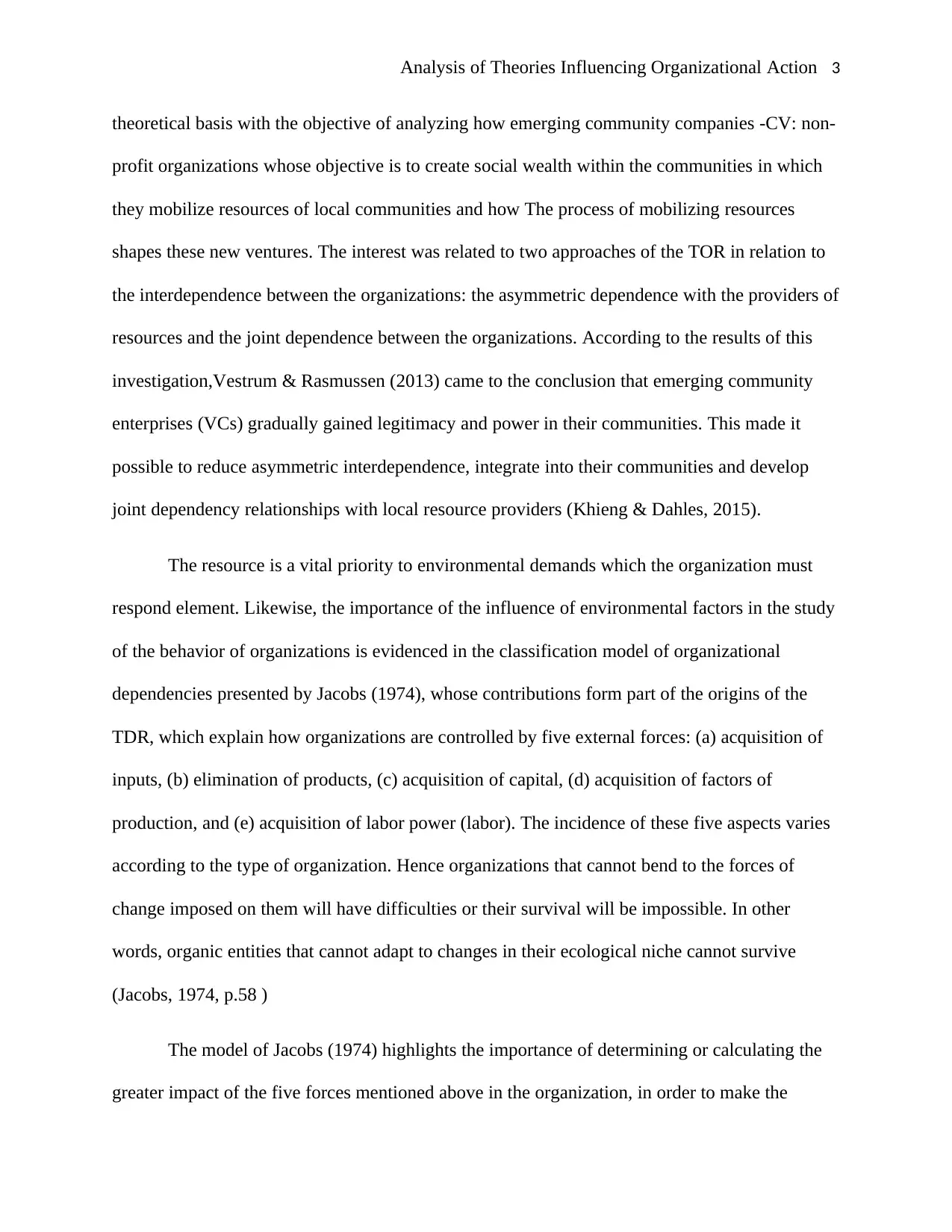
Analysis of Theories Influencing Organizational Action 3
theoretical basis with the objective of analyzing how emerging community companies -CV: non-
profit organizations whose objective is to create social wealth within the communities in which
they mobilize resources of local communities and how The process of mobilizing resources
shapes these new ventures. The interest was related to two approaches of the TOR in relation to
the interdependence between the organizations: the asymmetric dependence with the providers of
resources and the joint dependence between the organizations. According to the results of this
investigation,Vestrum & Rasmussen (2013) came to the conclusion that emerging community
enterprises (VCs) gradually gained legitimacy and power in their communities. This made it
possible to reduce asymmetric interdependence, integrate into their communities and develop
joint dependency relationships with local resource providers (Khieng & Dahles, 2015).
The resource is a vital priority to environmental demands which the organization must
respond element. Likewise, the importance of the influence of environmental factors in the study
of the behavior of organizations is evidenced in the classification model of organizational
dependencies presented by Jacobs (1974), whose contributions form part of the origins of the
TDR, which explain how organizations are controlled by five external forces: (a) acquisition of
inputs, (b) elimination of products, (c) acquisition of capital, (d) acquisition of factors of
production, and (e) acquisition of labor power (labor). The incidence of these five aspects varies
according to the type of organization. Hence organizations that cannot bend to the forces of
change imposed on them will have difficulties or their survival will be impossible. In other
words, organic entities that cannot adapt to changes in their ecological niche cannot survive
(Jacobs, 1974, p.58 )
The model of Jacobs (1974) highlights the importance of determining or calculating the
greater impact of the five forces mentioned above in the organization, in order to make the
theoretical basis with the objective of analyzing how emerging community companies -CV: non-
profit organizations whose objective is to create social wealth within the communities in which
they mobilize resources of local communities and how The process of mobilizing resources
shapes these new ventures. The interest was related to two approaches of the TOR in relation to
the interdependence between the organizations: the asymmetric dependence with the providers of
resources and the joint dependence between the organizations. According to the results of this
investigation,Vestrum & Rasmussen (2013) came to the conclusion that emerging community
enterprises (VCs) gradually gained legitimacy and power in their communities. This made it
possible to reduce asymmetric interdependence, integrate into their communities and develop
joint dependency relationships with local resource providers (Khieng & Dahles, 2015).
The resource is a vital priority to environmental demands which the organization must
respond element. Likewise, the importance of the influence of environmental factors in the study
of the behavior of organizations is evidenced in the classification model of organizational
dependencies presented by Jacobs (1974), whose contributions form part of the origins of the
TDR, which explain how organizations are controlled by five external forces: (a) acquisition of
inputs, (b) elimination of products, (c) acquisition of capital, (d) acquisition of factors of
production, and (e) acquisition of labor power (labor). The incidence of these five aspects varies
according to the type of organization. Hence organizations that cannot bend to the forces of
change imposed on them will have difficulties or their survival will be impossible. In other
words, organic entities that cannot adapt to changes in their ecological niche cannot survive
(Jacobs, 1974, p.58 )
The model of Jacobs (1974) highlights the importance of determining or calculating the
greater impact of the five forces mentioned above in the organization, in order to make the
⊘ This is a preview!⊘
Do you want full access?
Subscribe today to unlock all pages.

Trusted by 1+ million students worldwide
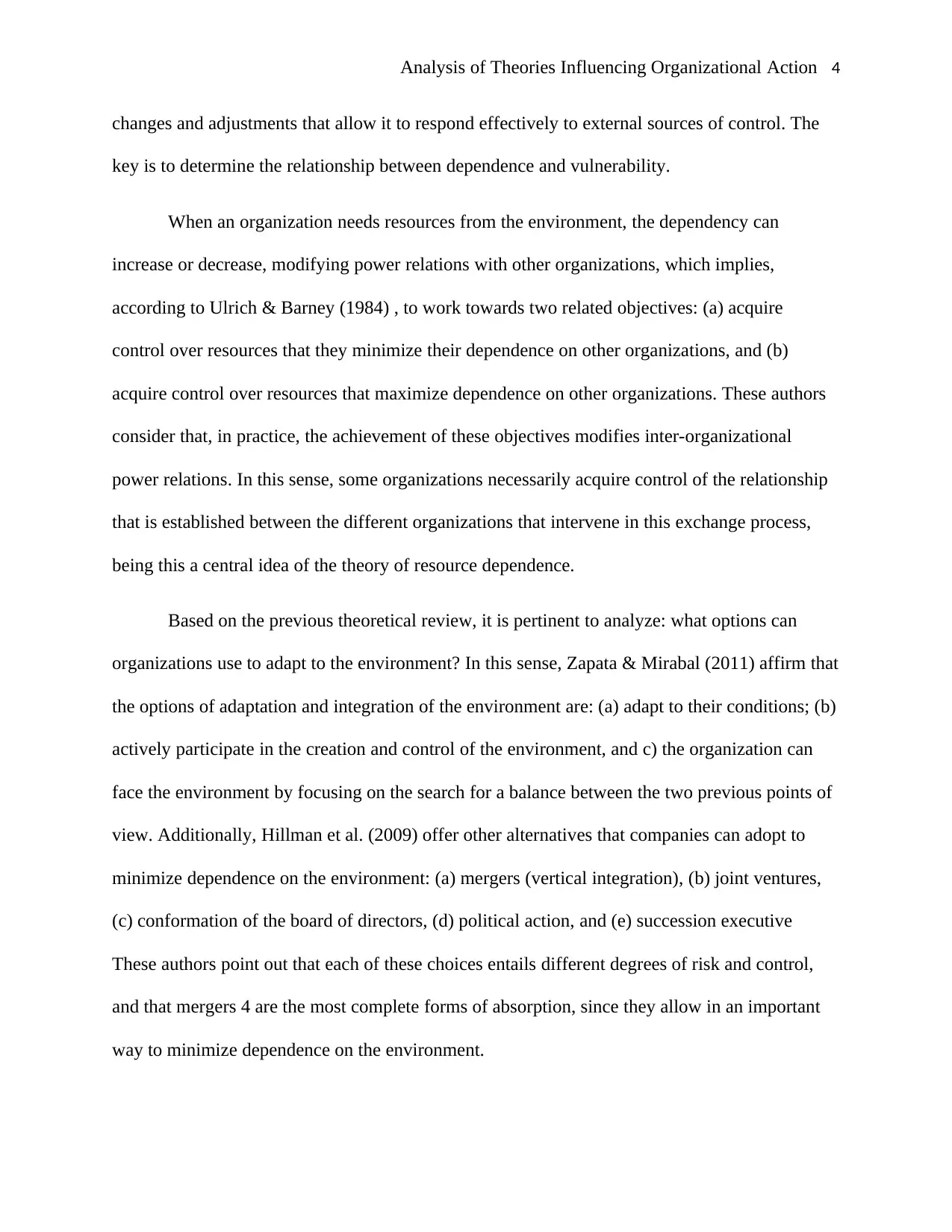
Analysis of Theories Influencing Organizational Action 4
changes and adjustments that allow it to respond effectively to external sources of control. The
key is to determine the relationship between dependence and vulnerability.
When an organization needs resources from the environment, the dependency can
increase or decrease, modifying power relations with other organizations, which implies,
according to Ulrich & Barney (1984) , to work towards two related objectives: (a) acquire
control over resources that they minimize their dependence on other organizations, and (b)
acquire control over resources that maximize dependence on other organizations. These authors
consider that, in practice, the achievement of these objectives modifies inter-organizational
power relations. In this sense, some organizations necessarily acquire control of the relationship
that is established between the different organizations that intervene in this exchange process,
being this a central idea of the theory of resource dependence.
Based on the previous theoretical review, it is pertinent to analyze: what options can
organizations use to adapt to the environment? In this sense, Zapata & Mirabal (2011) affirm that
the options of adaptation and integration of the environment are: (a) adapt to their conditions; (b)
actively participate in the creation and control of the environment, and c) the organization can
face the environment by focusing on the search for a balance between the two previous points of
view. Additionally, Hillman et al. (2009) offer other alternatives that companies can adopt to
minimize dependence on the environment: (a) mergers (vertical integration), (b) joint ventures,
(c) conformation of the board of directors, (d) political action, and (e) succession executive
These authors point out that each of these choices entails different degrees of risk and control,
and that mergers 4 are the most complete forms of absorption, since they allow in an important
way to minimize dependence on the environment.
changes and adjustments that allow it to respond effectively to external sources of control. The
key is to determine the relationship between dependence and vulnerability.
When an organization needs resources from the environment, the dependency can
increase or decrease, modifying power relations with other organizations, which implies,
according to Ulrich & Barney (1984) , to work towards two related objectives: (a) acquire
control over resources that they minimize their dependence on other organizations, and (b)
acquire control over resources that maximize dependence on other organizations. These authors
consider that, in practice, the achievement of these objectives modifies inter-organizational
power relations. In this sense, some organizations necessarily acquire control of the relationship
that is established between the different organizations that intervene in this exchange process,
being this a central idea of the theory of resource dependence.
Based on the previous theoretical review, it is pertinent to analyze: what options can
organizations use to adapt to the environment? In this sense, Zapata & Mirabal (2011) affirm that
the options of adaptation and integration of the environment are: (a) adapt to their conditions; (b)
actively participate in the creation and control of the environment, and c) the organization can
face the environment by focusing on the search for a balance between the two previous points of
view. Additionally, Hillman et al. (2009) offer other alternatives that companies can adopt to
minimize dependence on the environment: (a) mergers (vertical integration), (b) joint ventures,
(c) conformation of the board of directors, (d) political action, and (e) succession executive
These authors point out that each of these choices entails different degrees of risk and control,
and that mergers 4 are the most complete forms of absorption, since they allow in an important
way to minimize dependence on the environment.
Paraphrase This Document
Need a fresh take? Get an instant paraphrase of this document with our AI Paraphraser
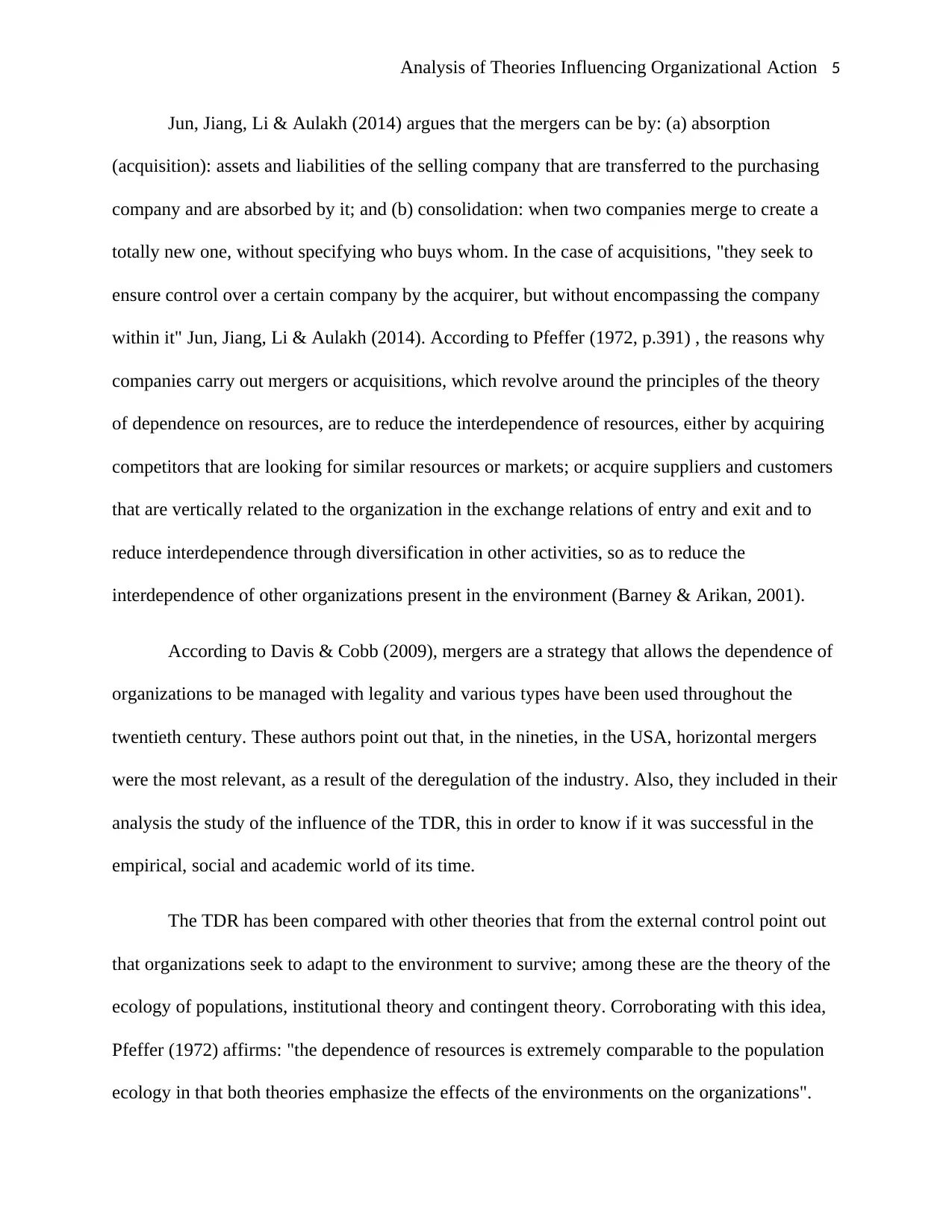
Analysis of Theories Influencing Organizational Action 5
Jun, Jiang, Li & Aulakh (2014) argues that the mergers can be by: (a) absorption
(acquisition): assets and liabilities of the selling company that are transferred to the purchasing
company and are absorbed by it; and (b) consolidation: when two companies merge to create a
totally new one, without specifying who buys whom. In the case of acquisitions, "they seek to
ensure control over a certain company by the acquirer, but without encompassing the company
within it" Jun, Jiang, Li & Aulakh (2014). According to Pfeffer (1972, p.391) , the reasons why
companies carry out mergers or acquisitions, which revolve around the principles of the theory
of dependence on resources, are to reduce the interdependence of resources, either by acquiring
competitors that are looking for similar resources or markets; or acquire suppliers and customers
that are vertically related to the organization in the exchange relations of entry and exit and to
reduce interdependence through diversification in other activities, so as to reduce the
interdependence of other organizations present in the environment (Barney & Arikan, 2001).
According to Davis & Cobb (2009), mergers are a strategy that allows the dependence of
organizations to be managed with legality and various types have been used throughout the
twentieth century. These authors point out that, in the nineties, in the USA, horizontal mergers
were the most relevant, as a result of the deregulation of the industry. Also, they included in their
analysis the study of the influence of the TDR, this in order to know if it was successful in the
empirical, social and academic world of its time.
The TDR has been compared with other theories that from the external control point out
that organizations seek to adapt to the environment to survive; among these are the theory of the
ecology of populations, institutional theory and contingent theory. Corroborating with this idea,
Pfeffer (1972) affirms: "the dependence of resources is extremely comparable to the population
ecology in that both theories emphasize the effects of the environments on the organizations".
Jun, Jiang, Li & Aulakh (2014) argues that the mergers can be by: (a) absorption
(acquisition): assets and liabilities of the selling company that are transferred to the purchasing
company and are absorbed by it; and (b) consolidation: when two companies merge to create a
totally new one, without specifying who buys whom. In the case of acquisitions, "they seek to
ensure control over a certain company by the acquirer, but without encompassing the company
within it" Jun, Jiang, Li & Aulakh (2014). According to Pfeffer (1972, p.391) , the reasons why
companies carry out mergers or acquisitions, which revolve around the principles of the theory
of dependence on resources, are to reduce the interdependence of resources, either by acquiring
competitors that are looking for similar resources or markets; or acquire suppliers and customers
that are vertically related to the organization in the exchange relations of entry and exit and to
reduce interdependence through diversification in other activities, so as to reduce the
interdependence of other organizations present in the environment (Barney & Arikan, 2001).
According to Davis & Cobb (2009), mergers are a strategy that allows the dependence of
organizations to be managed with legality and various types have been used throughout the
twentieth century. These authors point out that, in the nineties, in the USA, horizontal mergers
were the most relevant, as a result of the deregulation of the industry. Also, they included in their
analysis the study of the influence of the TDR, this in order to know if it was successful in the
empirical, social and academic world of its time.
The TDR has been compared with other theories that from the external control point out
that organizations seek to adapt to the environment to survive; among these are the theory of the
ecology of populations, institutional theory and contingent theory. Corroborating with this idea,
Pfeffer (1972) affirms: "the dependence of resources is extremely comparable to the population
ecology in that both theories emphasize the effects of the environments on the organizations".
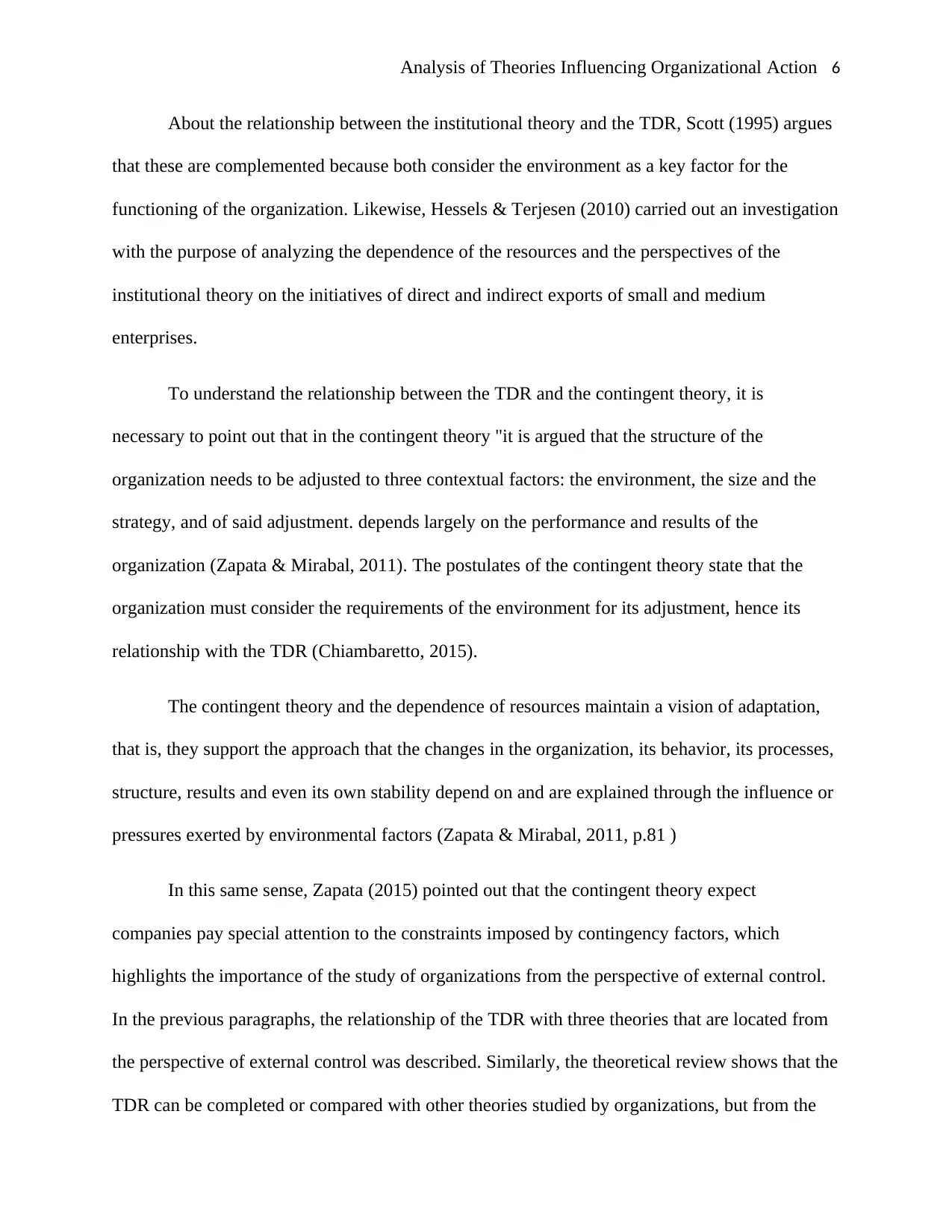
Analysis of Theories Influencing Organizational Action 6
About the relationship between the institutional theory and the TDR, Scott (1995) argues
that these are complemented because both consider the environment as a key factor for the
functioning of the organization. Likewise, Hessels & Terjesen (2010) carried out an investigation
with the purpose of analyzing the dependence of the resources and the perspectives of the
institutional theory on the initiatives of direct and indirect exports of small and medium
enterprises.
To understand the relationship between the TDR and the contingent theory, it is
necessary to point out that in the contingent theory "it is argued that the structure of the
organization needs to be adjusted to three contextual factors: the environment, the size and the
strategy, and of said adjustment. depends largely on the performance and results of the
organization (Zapata & Mirabal, 2011). The postulates of the contingent theory state that the
organization must consider the requirements of the environment for its adjustment, hence its
relationship with the TDR (Chiambaretto, 2015).
The contingent theory and the dependence of resources maintain a vision of adaptation,
that is, they support the approach that the changes in the organization, its behavior, its processes,
structure, results and even its own stability depend on and are explained through the influence or
pressures exerted by environmental factors (Zapata & Mirabal, 2011, p.81 )
In this same sense, Zapata (2015) pointed out that the contingent theory expect
companies pay special attention to the constraints imposed by contingency factors, which
highlights the importance of the study of organizations from the perspective of external control.
In the previous paragraphs, the relationship of the TDR with three theories that are located from
the perspective of external control was described. Similarly, the theoretical review shows that the
TDR can be completed or compared with other theories studied by organizations, but from the
About the relationship between the institutional theory and the TDR, Scott (1995) argues
that these are complemented because both consider the environment as a key factor for the
functioning of the organization. Likewise, Hessels & Terjesen (2010) carried out an investigation
with the purpose of analyzing the dependence of the resources and the perspectives of the
institutional theory on the initiatives of direct and indirect exports of small and medium
enterprises.
To understand the relationship between the TDR and the contingent theory, it is
necessary to point out that in the contingent theory "it is argued that the structure of the
organization needs to be adjusted to three contextual factors: the environment, the size and the
strategy, and of said adjustment. depends largely on the performance and results of the
organization (Zapata & Mirabal, 2011). The postulates of the contingent theory state that the
organization must consider the requirements of the environment for its adjustment, hence its
relationship with the TDR (Chiambaretto, 2015).
The contingent theory and the dependence of resources maintain a vision of adaptation,
that is, they support the approach that the changes in the organization, its behavior, its processes,
structure, results and even its own stability depend on and are explained through the influence or
pressures exerted by environmental factors (Zapata & Mirabal, 2011, p.81 )
In this same sense, Zapata (2015) pointed out that the contingent theory expect
companies pay special attention to the constraints imposed by contingency factors, which
highlights the importance of the study of organizations from the perspective of external control.
In the previous paragraphs, the relationship of the TDR with three theories that are located from
the perspective of external control was described. Similarly, the theoretical review shows that the
TDR can be completed or compared with other theories studied by organizations, but from the
⊘ This is a preview!⊘
Do you want full access?
Subscribe today to unlock all pages.

Trusted by 1+ million students worldwide
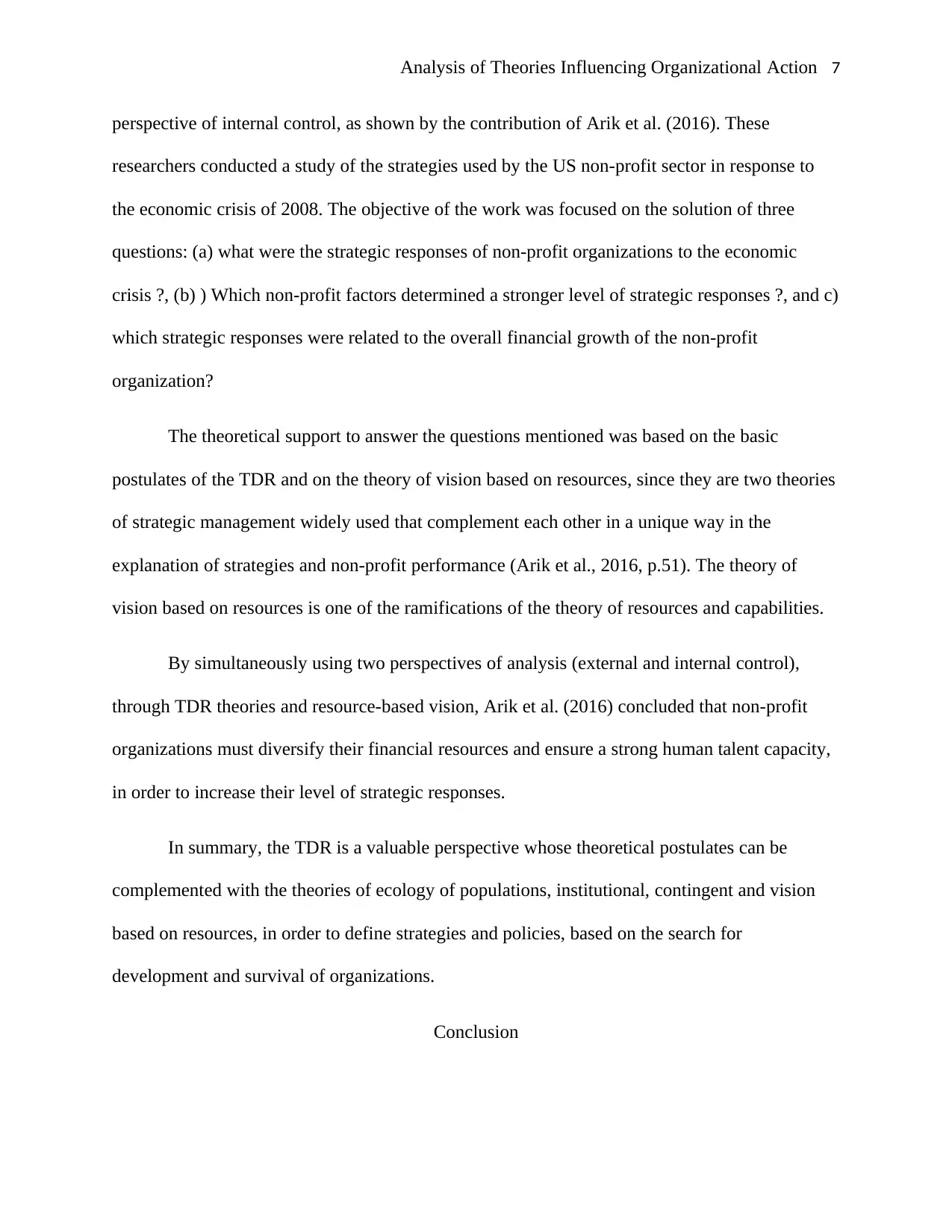
Analysis of Theories Influencing Organizational Action 7
perspective of internal control, as shown by the contribution of Arik et al. (2016). These
researchers conducted a study of the strategies used by the US non-profit sector in response to
the economic crisis of 2008. The objective of the work was focused on the solution of three
questions: (a) what were the strategic responses of non-profit organizations to the economic
crisis ?, (b) ) Which non-profit factors determined a stronger level of strategic responses ?, and c)
which strategic responses were related to the overall financial growth of the non-profit
organization?
The theoretical support to answer the questions mentioned was based on the basic
postulates of the TDR and on the theory of vision based on resources, since they are two theories
of strategic management widely used that complement each other in a unique way in the
explanation of strategies and non-profit performance (Arik et al., 2016, p.51). The theory of
vision based on resources is one of the ramifications of the theory of resources and capabilities.
By simultaneously using two perspectives of analysis (external and internal control),
through TDR theories and resource-based vision, Arik et al. (2016) concluded that non-profit
organizations must diversify their financial resources and ensure a strong human talent capacity,
in order to increase their level of strategic responses.
In summary, the TDR is a valuable perspective whose theoretical postulates can be
complemented with the theories of ecology of populations, institutional, contingent and vision
based on resources, in order to define strategies and policies, based on the search for
development and survival of organizations.
Conclusion
perspective of internal control, as shown by the contribution of Arik et al. (2016). These
researchers conducted a study of the strategies used by the US non-profit sector in response to
the economic crisis of 2008. The objective of the work was focused on the solution of three
questions: (a) what were the strategic responses of non-profit organizations to the economic
crisis ?, (b) ) Which non-profit factors determined a stronger level of strategic responses ?, and c)
which strategic responses were related to the overall financial growth of the non-profit
organization?
The theoretical support to answer the questions mentioned was based on the basic
postulates of the TDR and on the theory of vision based on resources, since they are two theories
of strategic management widely used that complement each other in a unique way in the
explanation of strategies and non-profit performance (Arik et al., 2016, p.51). The theory of
vision based on resources is one of the ramifications of the theory of resources and capabilities.
By simultaneously using two perspectives of analysis (external and internal control),
through TDR theories and resource-based vision, Arik et al. (2016) concluded that non-profit
organizations must diversify their financial resources and ensure a strong human talent capacity,
in order to increase their level of strategic responses.
In summary, the TDR is a valuable perspective whose theoretical postulates can be
complemented with the theories of ecology of populations, institutional, contingent and vision
based on resources, in order to define strategies and policies, based on the search for
development and survival of organizations.
Conclusion
Paraphrase This Document
Need a fresh take? Get an instant paraphrase of this document with our AI Paraphraser
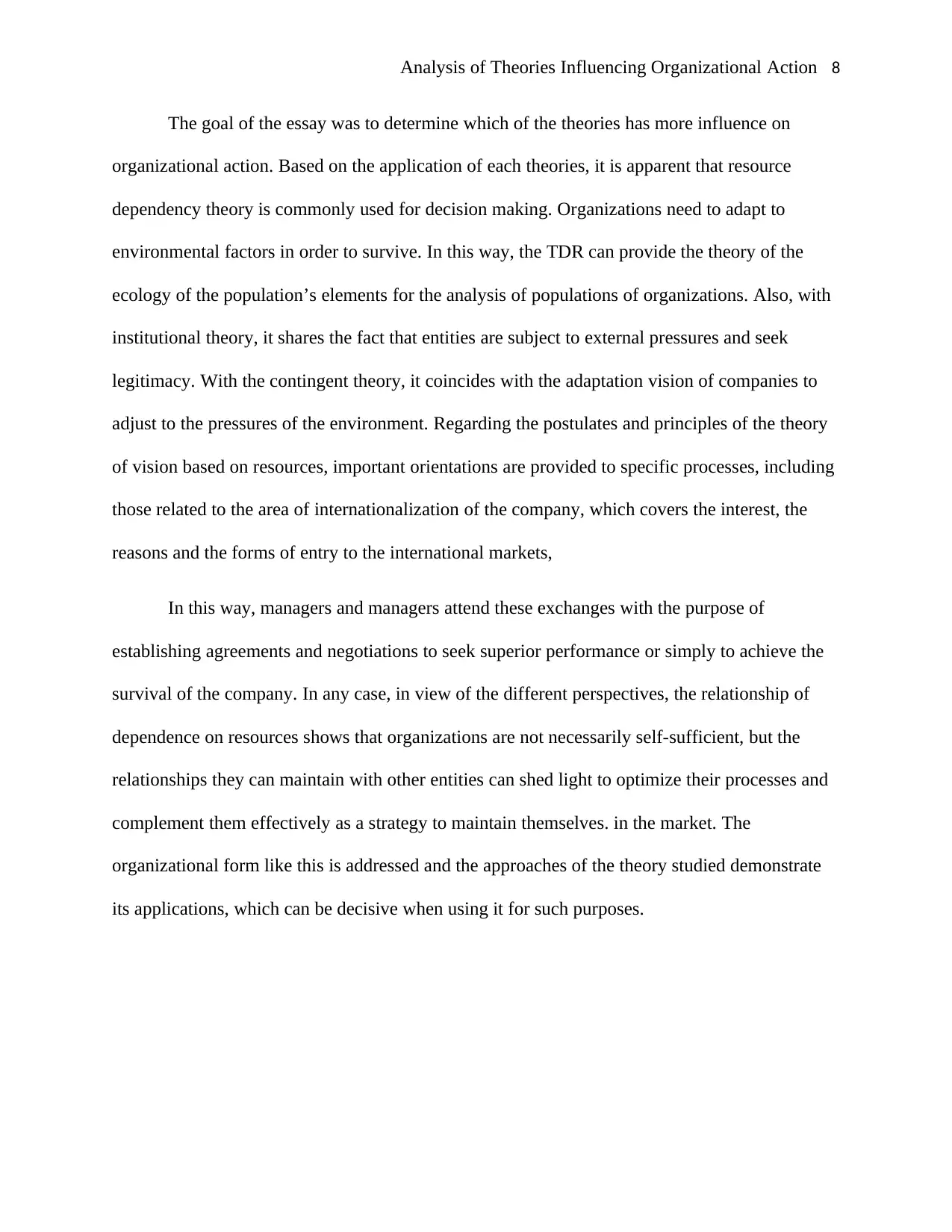
Analysis of Theories Influencing Organizational Action 8
The goal of the essay was to determine which of the theories has more influence on
organizational action. Based on the application of each theories, it is apparent that resource
dependency theory is commonly used for decision making. Organizations need to adapt to
environmental factors in order to survive. In this way, the TDR can provide the theory of the
ecology of the population’s elements for the analysis of populations of organizations. Also, with
institutional theory, it shares the fact that entities are subject to external pressures and seek
legitimacy. With the contingent theory, it coincides with the adaptation vision of companies to
adjust to the pressures of the environment. Regarding the postulates and principles of the theory
of vision based on resources, important orientations are provided to specific processes, including
those related to the area of internationalization of the company, which covers the interest, the
reasons and the forms of entry to the international markets,
In this way, managers and managers attend these exchanges with the purpose of
establishing agreements and negotiations to seek superior performance or simply to achieve the
survival of the company. In any case, in view of the different perspectives, the relationship of
dependence on resources shows that organizations are not necessarily self-sufficient, but the
relationships they can maintain with other entities can shed light to optimize their processes and
complement them effectively as a strategy to maintain themselves. in the market. The
organizational form like this is addressed and the approaches of the theory studied demonstrate
its applications, which can be decisive when using it for such purposes.
The goal of the essay was to determine which of the theories has more influence on
organizational action. Based on the application of each theories, it is apparent that resource
dependency theory is commonly used for decision making. Organizations need to adapt to
environmental factors in order to survive. In this way, the TDR can provide the theory of the
ecology of the population’s elements for the analysis of populations of organizations. Also, with
institutional theory, it shares the fact that entities are subject to external pressures and seek
legitimacy. With the contingent theory, it coincides with the adaptation vision of companies to
adjust to the pressures of the environment. Regarding the postulates and principles of the theory
of vision based on resources, important orientations are provided to specific processes, including
those related to the area of internationalization of the company, which covers the interest, the
reasons and the forms of entry to the international markets,
In this way, managers and managers attend these exchanges with the purpose of
establishing agreements and negotiations to seek superior performance or simply to achieve the
survival of the company. In any case, in view of the different perspectives, the relationship of
dependence on resources shows that organizations are not necessarily self-sufficient, but the
relationships they can maintain with other entities can shed light to optimize their processes and
complement them effectively as a strategy to maintain themselves. in the market. The
organizational form like this is addressed and the approaches of the theory studied demonstrate
its applications, which can be decisive when using it for such purposes.
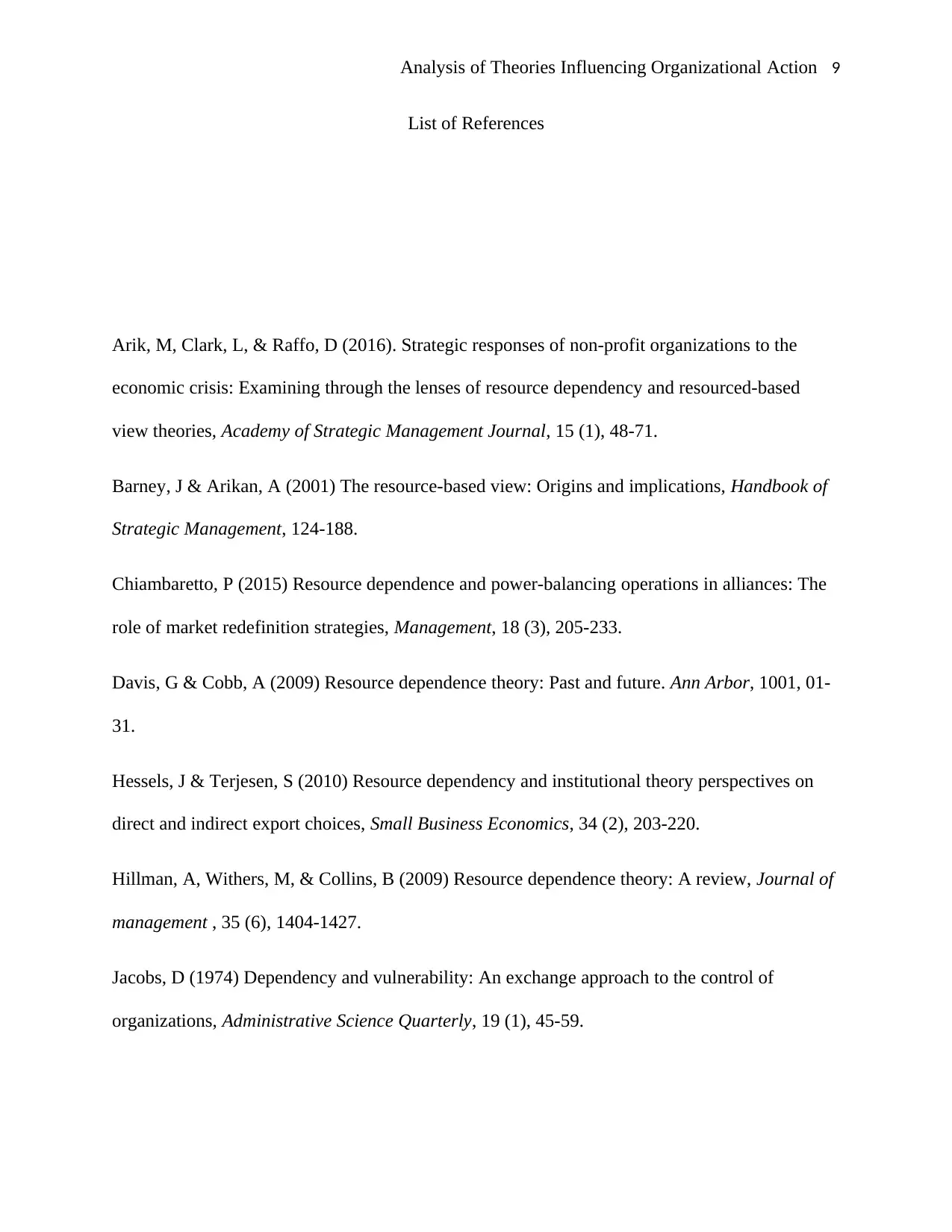
Analysis of Theories Influencing Organizational Action 9
List of References
Arik, M, Clark, L, & Raffo, D (2016). Strategic responses of non-profit organizations to the
economic crisis: Examining through the lenses of resource dependency and resourced-based
view theories, Academy of Strategic Management Journal, 15 (1), 48-71.
Barney, J & Arikan, A (2001) The resource-based view: Origins and implications, Handbook of
Strategic Management, 124-188.
Chiambaretto, P (2015) Resource dependence and power-balancing operations in alliances: The
role of market redefinition strategies, Management, 18 (3), 205-233.
Davis, G & Cobb, A (2009) Resource dependence theory: Past and future. Ann Arbor, 1001, 01-
31.
Hessels, J & Terjesen, S (2010) Resource dependency and institutional theory perspectives on
direct and indirect export choices, Small Business Economics, 34 (2), 203-220.
Hillman, A, Withers, M, & Collins, B (2009) Resource dependence theory: A review, Journal of
management , 35 (6), 1404-1427.
Jacobs, D (1974) Dependency and vulnerability: An exchange approach to the control of
organizations, Administrative Science Quarterly, 19 (1), 45-59.
List of References
Arik, M, Clark, L, & Raffo, D (2016). Strategic responses of non-profit organizations to the
economic crisis: Examining through the lenses of resource dependency and resourced-based
view theories, Academy of Strategic Management Journal, 15 (1), 48-71.
Barney, J & Arikan, A (2001) The resource-based view: Origins and implications, Handbook of
Strategic Management, 124-188.
Chiambaretto, P (2015) Resource dependence and power-balancing operations in alliances: The
role of market redefinition strategies, Management, 18 (3), 205-233.
Davis, G & Cobb, A (2009) Resource dependence theory: Past and future. Ann Arbor, 1001, 01-
31.
Hessels, J & Terjesen, S (2010) Resource dependency and institutional theory perspectives on
direct and indirect export choices, Small Business Economics, 34 (2), 203-220.
Hillman, A, Withers, M, & Collins, B (2009) Resource dependence theory: A review, Journal of
management , 35 (6), 1404-1427.
Jacobs, D (1974) Dependency and vulnerability: An exchange approach to the control of
organizations, Administrative Science Quarterly, 19 (1), 45-59.
⊘ This is a preview!⊘
Do you want full access?
Subscribe today to unlock all pages.

Trusted by 1+ million students worldwide
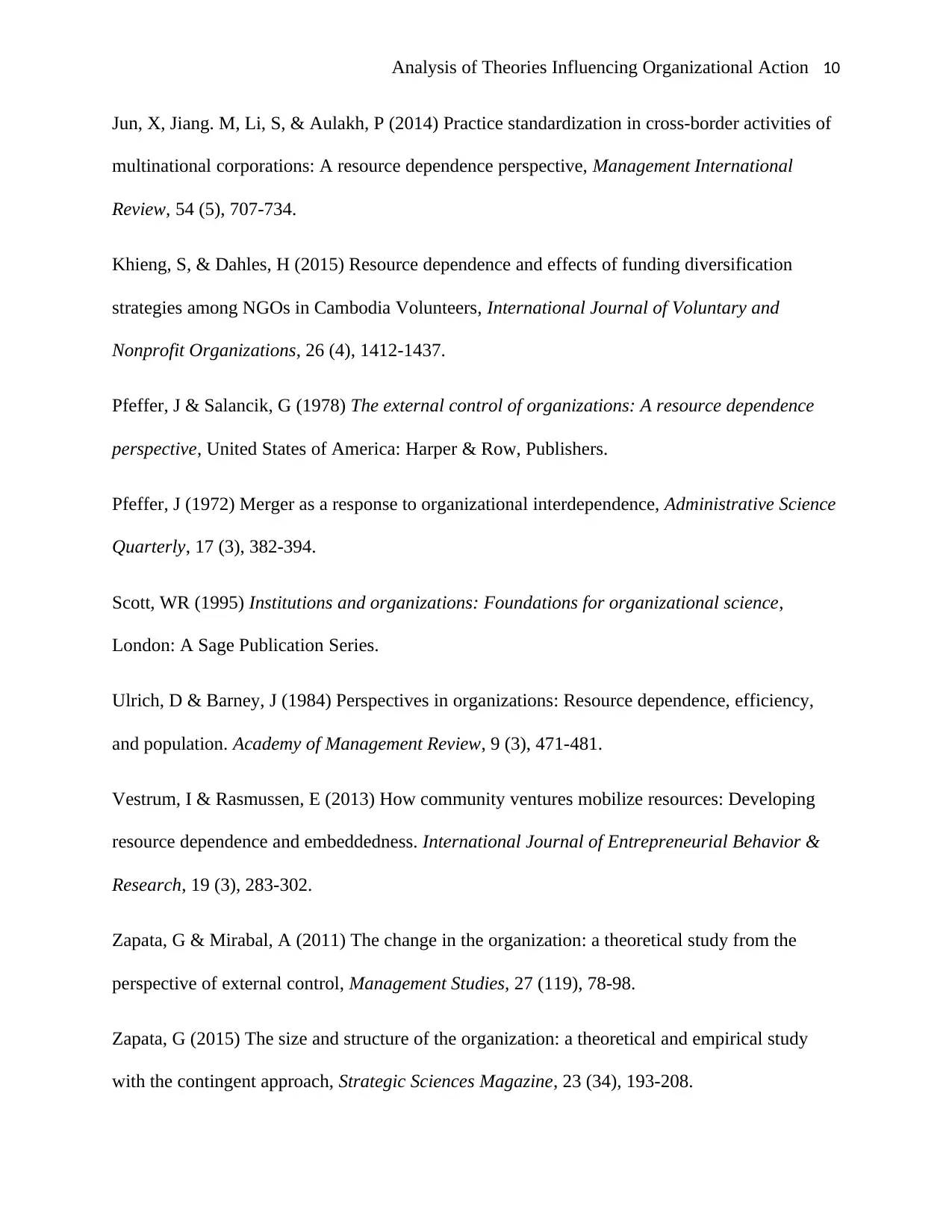
Analysis of Theories Influencing Organizational Action 10
Jun, X, Jiang. M, Li, S, & Aulakh, P (2014) Practice standardization in cross-border activities of
multinational corporations: A resource dependence perspective, Management International
Review, 54 (5), 707-734.
Khieng, S, & Dahles, H (2015) Resource dependence and effects of funding diversification
strategies among NGOs in Cambodia Volunteers, International Journal of Voluntary and
Nonprofit Organizations, 26 (4), 1412-1437.
Pfeffer, J & Salancik, G (1978) The external control of organizations: A resource dependence
perspective, United States of America: Harper & Row, Publishers.
Pfeffer, J (1972) Merger as a response to organizational interdependence, Administrative Science
Quarterly, 17 (3), 382-394.
Scott, WR (1995) Institutions and organizations: Foundations for organizational science,
London: A Sage Publication Series.
Ulrich, D & Barney, J (1984) Perspectives in organizations: Resource dependence, efficiency,
and population. Academy of Management Review, 9 (3), 471-481.
Vestrum, I & Rasmussen, E (2013) How community ventures mobilize resources: Developing
resource dependence and embeddedness. International Journal of Entrepreneurial Behavior &
Research, 19 (3), 283-302.
Zapata, G & Mirabal, A (2011) The change in the organization: a theoretical study from the
perspective of external control, Management Studies, 27 (119), 78-98.
Zapata, G (2015) The size and structure of the organization: a theoretical and empirical study
with the contingent approach, Strategic Sciences Magazine, 23 (34), 193-208.
Jun, X, Jiang. M, Li, S, & Aulakh, P (2014) Practice standardization in cross-border activities of
multinational corporations: A resource dependence perspective, Management International
Review, 54 (5), 707-734.
Khieng, S, & Dahles, H (2015) Resource dependence and effects of funding diversification
strategies among NGOs in Cambodia Volunteers, International Journal of Voluntary and
Nonprofit Organizations, 26 (4), 1412-1437.
Pfeffer, J & Salancik, G (1978) The external control of organizations: A resource dependence
perspective, United States of America: Harper & Row, Publishers.
Pfeffer, J (1972) Merger as a response to organizational interdependence, Administrative Science
Quarterly, 17 (3), 382-394.
Scott, WR (1995) Institutions and organizations: Foundations for organizational science,
London: A Sage Publication Series.
Ulrich, D & Barney, J (1984) Perspectives in organizations: Resource dependence, efficiency,
and population. Academy of Management Review, 9 (3), 471-481.
Vestrum, I & Rasmussen, E (2013) How community ventures mobilize resources: Developing
resource dependence and embeddedness. International Journal of Entrepreneurial Behavior &
Research, 19 (3), 283-302.
Zapata, G & Mirabal, A (2011) The change in the organization: a theoretical study from the
perspective of external control, Management Studies, 27 (119), 78-98.
Zapata, G (2015) The size and structure of the organization: a theoretical and empirical study
with the contingent approach, Strategic Sciences Magazine, 23 (34), 193-208.
Paraphrase This Document
Need a fresh take? Get an instant paraphrase of this document with our AI Paraphraser
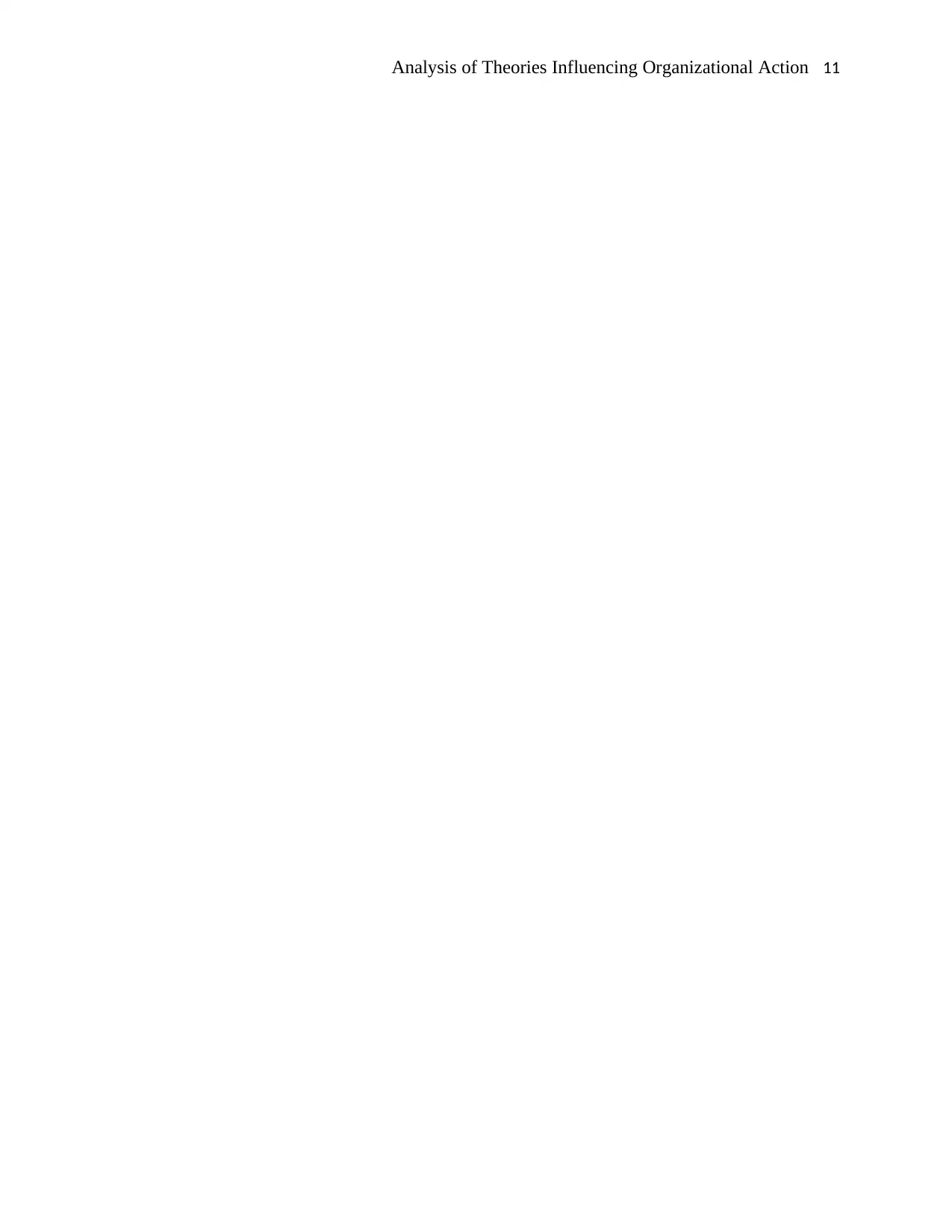
Analysis of Theories Influencing Organizational Action 11
1 out of 11
Related Documents
Your All-in-One AI-Powered Toolkit for Academic Success.
+13062052269
info@desklib.com
Available 24*7 on WhatsApp / Email
![[object Object]](/_next/static/media/star-bottom.7253800d.svg)
Unlock your academic potential
Copyright © 2020–2025 A2Z Services. All Rights Reserved. Developed and managed by ZUCOL.





